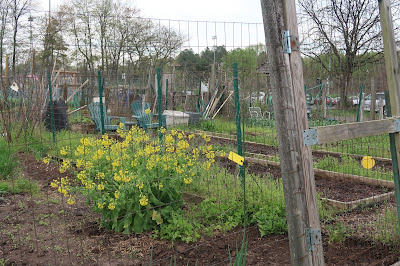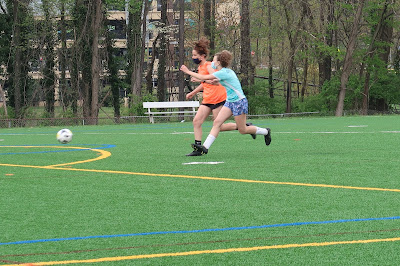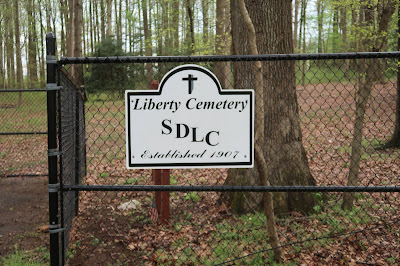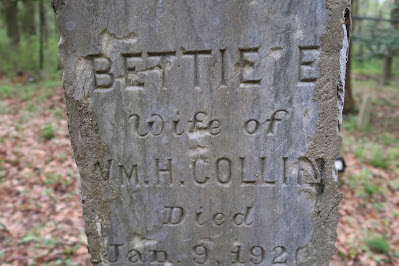Explore a Park: Pine Ridge Park displaced a small Black community
 |
| The Bo White Community Gardens |
This article is part of our series on parks in the Annandale/Mason District area. The last piece in this series explored Toll House Park.
The 42.7-acre Pine Ridge Park in Annandale features several ball fields, community gardens, a trail through the woods, a cemetery, and a fascinating history. The site was once home to a small African American community, but those families were forced to leave to make way for a new public school. That school was never built.
 |
| Girls practice soccer on the turf field. |
Features: Athletic facilities include three baseball fields and a batting cage adopted by the Annandale North Springfield Little League (ANSLL); two grass fields and a turf field used for soccer, lacrosse, and other sports; restrooms; and a concession stand.
In exchange for maintaining the baseball diamonds, ANSLL gets first priority in using them. Those fields are named for individuals who have contributed to Fairfax County athletics and recreation programs: Lee Pfaff, Bill Lamb, and Bob Allgaier.
 |
| The Annandale North Springfield Little League takes care of the baseball facilities. |
The Fairfax County Park Authority Board approved an $11,000 Mastenbrook matching grant April 14 for ANSLL to repair the batting cages and replace the backstop and install new bullpens on field 2.
The Bo White Community Gardens – with 159 rentable garden plots – is named for Bo White, the former Mason District representative on the Park Authority Board.
The Sons & Daughters of Liberty Cemetery is completely surrounded by Pine Ridge Park but is not part of the park.
 |
| The cemetery in Pine Ridge Park. |
Access: The main entrance to Pine Ridge Park is at 3401 Woodburn Road. There’s also a paved trail leading to the park from Chivalry Road in the Camelot neighborhood in Annandale.
History: In 1893, according to a now defunct local newspaper, The Region, the Collins family and others purchased 10 acres of land in what is now part of Pine Ridge Park. That area became a small Black enclave known first as The Mason Tract and later as The Pines.
 |
| The descendants of families who lived in The Pines returned to Pine Ridge Park for the dedication of the historic marker. |
According to the Fairfax County Cemetery Survey, a quarter-acre parcel that community was deeded to Ebenezer Lodge No. 14, Sons & Daughters of Liberty, in 1907 for use as a graveyard.
The cemetery and surrounding property (22 acres) was condemned by the Fairfax County School Board in 1965 and acquired for construction of a 2,000-student intermediate school.
 |
| A trail to Pine Ridge Park from Chivalry Road in Camelot. |
That school was never built, according to a Washington Post article published in 2000. Instead, the school board converted the all-Black Luther Jackson High School to an integrated intermediate school.
The school board then planned to build a new high school on what is now Pine Ridge Park, but needed 20 more acres.
The board forced the Collins family to sell out under threat of condemnation and demolished the family’s homes. The proposed Pine Ridge High School was never built.
 |
| Lacrosse practice |
In 2016, the Fairfax County History Commission erected a historic marker to commemorate The Pines.
Descendants of the Collins family and other families shared their memories about life in The Pines during the dedication ceremony for the marker. William Collins Sr., the descendant of free slaves bought 22 acres in 1905 with money saved from serving with Teddy Roosevelt’s Rough Riders in the Spanish American War. The Johnson, Robinson, and Sprigg families also purchased lots there. The residents operated small truck farms and a sawmill.
 |
| An oak tree dedicated to Fred Ward, the first elected school board member from Mason District. He served from 1995 to 1999. |
“The Pines was filled with love, it was filled with laughter, it was filled with food, and music, and God,” said Avonjeanette Hill, who lived there as a child. “It was extremely comforting to have a place that was secure.” Her father, William Collins Jr., had a library and music room in the house and everyone gathered around the piano after church on Sunday to sing gospel songs.
After they were forced to leave in 1965, several residents of The Pines relocated to Williamstown, an African American community in Falls Church.
 |
| A trail through the wooded area of Pine Ridge Park. |
The school board leased the property to the Park Authority in 1981, and the Park Authority constructed ballfields in 1983.
Meanwhile, the cemetery was not maintained and suffered severely from neglect and vandalism, the cemetery survey states. Only one original gravestone survives. That marker is for Bettie E. Collins, wife of Wh. H. Collins. She died in 1920 at age 39.
In 1990 the School Board cleared, fenced, and surveyed the site for burials, relocating 45 graves that had been buried under the athletic fields.
 |
| The gravestone for Bettie Collins |
Some of the other family names on gravestones in the cemetery are Ransell, Whitney, Robinson, Burke, Turner, Coates, Marshall, Brent, Gaskins, Davis, Luckett, and Badil-Abish.
The School Board considered selling the land to a developer, the Washington Post reported in 1997. A proposal by Northern Virginia Community College to build a medical education campus on the site was shot down following intense community opposition. In 2000, the Board of Supervisors agreed to purchase the land from the School Board.
 |
| New growth in the garden plots. |
The School Board opposed that plan. A compromise was eventually reached calling for the county to give FCPS title to its administration building in Fairfax plus $6.2 million toward FCPS’s bond debt.
According to the Fairfax County Park Authority’s Master Plan for Pine Ridge Park, the land contains a 4,000-year-old archaic Native American tool-making site and a four-foot diameter stone water well, most likely constructed in the late 18th or early 19th century.


Give the land back!
Bring more black people to the area and give them the land!
I am following in the Los Angeles Times the news of reparations in the case of Bruce's Beach, the Manhattan Beach, California property seized by eminent domain from a Black family in 1924. It was operated by the Bruce family as a cafe/dance hall/lodge to give Black families a getaway on the coast. The justification was "urgent need for a public park" — which was never created.
Given just the glimpse we have into eminent domain takings, from this Blog, at Pine Ridge Park, at Justice Park, and Justice High School, it seems appropriate and fitting to have a reveal, reconciliation, reckoning, reparations of some kind, of any and all such takings and displacement in Fairfax County. And, to build appropriate recognition of Native American lives lived on these lands.
Starting now.
Yes, i read that, very interesting.
Agree with above. More and more people in northern VA and beyond are learning that their ancestors were either slaveholders or enslaved. Reparations are called for, however difficult it may be to figure out how to do it.
Reparations??????? You liberals are out of your fucking minds.
Why? It is only fair.
But reparations is no enough, we will not learn our lesson unless we are forced to give back the land and our houses back to their original black residents.
Everyone who's single family house was built on such land should give it back.
With your obvious disregard for social justice aside, we collectively pay for much more inane bullshit than "reparations?????" yearly. In fact, we waste millions of dollars each year just so that bureaucrats won't get their budgets cut the next fiscal year.
We could be spending much more effectively, and reparations are just a drop in the bucket.